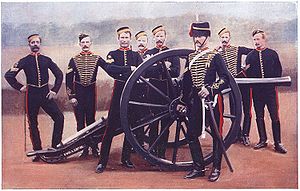- Ordnance BL 12 pounder 7 cwt
-
Ordnance BL 12 pounder 7 cwt 
With Royal Horse Artillery crewType Field gun Place of origin  United Kingdom
United KingdomService history In service 1885- 1895 Used by British Empire Production history Designed 1883 Specifications Weight 784 pounds (356 kg) barrel & breech Barrel length 84 inches (2,134 mm) bore (28 calibres) Shell separate loading BL, 12.5 lb (5.7 kg) Shrapnel Calibre 3-inch (76.2 mm) Traverse nil Muzzle velocity 1,710 feet per second (520 m/s)[1] Maximum range 5,000 yards (4,600 m)[2] The Ordnance BL 12 pounder 7cwt was the British Army's field gun, which succeed the RML 13 pounder 8 cwt in 1885.
Contents
History
The gun was initially adopted by both the Royal Field Artillery and Royal Horse Artillery, and was in full service by 1885. It marked a return to breech-loading guns, after the British army had reverted to muzzle-loaders in the late 1860s following the failure of the Armstrong screw breech guns.
Problems arose when it was used by the Horse Artillery in the great Indian cavalry manoeuvres of 1891. The carriage was found to be too complicated and dust caused the metal surfaces of the axle traversing device to seize.[3] It also proved too heavy to manoeuvre for horse artillery, which was intended to support cavalry in battle.
The 12 pounder 6 cwt gun was thus developed in 1892, when the new more powerful cordite replaced gunpowder, as a lighter alternative. It had a barrel 18 inches (460 mm) shorter, on a lighter and simpler carriage, and it entered service with the Royal Horse Artillery in 1894.
The introduction of Cordite also led to the decision that the 12 pounder was capable of firing a heavier shell up to 15 lb (6.8 kg). A 14 pound shell was adopted and the gun became a "15 pounder" from 1895.[4] At that point the 12 pounder 7 cwt became redundant.
Combat use
The gun was normally towed by 6 horses, in 3 pairs.
See also
- Field artillery
- List of field guns
Surviving examples
Notes
References
- Text Book of Gunnery, 1902. LONDON : PRINTED FOR HIS MAJESTY'S STATIONERY OFFICE, BY HARRISON AND SONS, ST. MARTIN'S LANE
- Dale Clarke, British Artillery 1914-1919. Field Army Artillery. Osprey Publishing, Oxford UK, 2004
- Major Darrell D. Hall, "Field Artillery of the British Army 1860-1960. Part I, 1860 - 1900" in The South African Military History Society. Military History Journal - Vol 2 No 4, December 1972
External links
British Empire Small Arms & Ordnance of the Victorian era 
Side arms Muskets and Rifles Brown Bess musket · Baker rifle · Brunswick rifle · Pattern 1851 Minié rifle · Pattern 1853 Enfield rifle-musket · Snider-Enfield rifle · Martini-Henry rifle · Lee-Metford rifle · Magazine Lee-Enfield (MLE) rifleArtillery Field Artillery SBML 9 pounder 13 cwt · RBL 9 pounder · RBL 12 pounder · RBL 20 pounder · RML 9 pounder 8 cwt · RML 13 pounder 8 cwt · RML 16 pounder 12 cwt · BL 12 pounder 7 cwt · BL 12 pounder 6 cwt · QF 12 pounder 8 cwt · BL 15 pounder · QF 1 pounder pom-pomMountain artillery Howitzers, medium,
and heavy artillerySiege & garrison artillery SBBL 32 pounder · SBML 24 pounder · SBML 8 inch 65 cwt · RBL 40 pounder · RML 25 pounder 18 cwt · RML 40 pounder gun · RML 64 pounder 64 cwt gun · RML 64 pounder 58 cwt · RML 64 pounder 71 cwt gun · RML 80 pounder · RML 6.6. inch gun · RML 8 inch howitzer · BL 5 inch gun Mk I - V · BL 6 inch 30 cwt howitzerMortars 13 inch 36 cwt mortar · 10 inch 18 cwt mortar · 8 inch 9 cwt mortarWar rockets Congreve 6-pounder · Congreve 12-pounder · Congreve 24-pounder · Boxer · Hales 9-pounder · Hales 24-pounderMachine guns Categories:- Artillery of the United Kingdom
- 76 mm artillery
- Field guns
Wikimedia Foundation. 2010.
